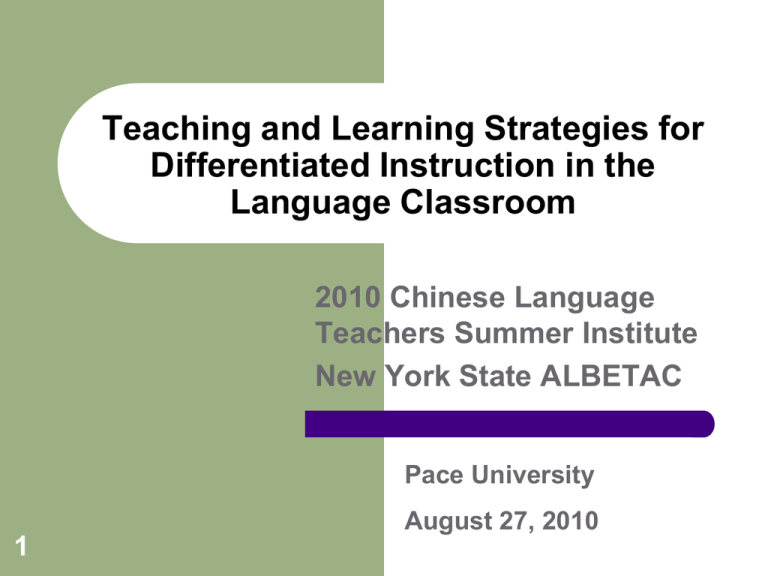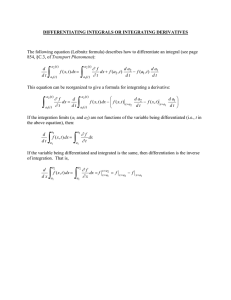
Teaching and Learning Strategies for
Differentiated Instruction in the
Language Classroom
2010 Chinese Language
Teachers Summer Institute
New York State ALBETAC
Pace University
August 27, 2010
1
Reach and Teach All Children
When a teacher tries to teach something to the
entire class at the same time, “chances are, onethird of the kids already know it; one-third will get
it; and the remaining third won‟t. So two-thirds
of the children are wasting their time.”
Lillian Katz
How are we bridging the gap?
3
Reach and Teach All Children
If children do not learn the
way we teach them, then we
must teach them the way
they learn.
4
By the end of this session…
5
Participants will have a clear understanding of what
differentiation is and is not.
Participants will work on assessing their learning
styles and will receive sample assessments that can
be used as models for the rest of the school year.
Based on assessment results, participants will make
practical applications of their findings. They will
differentiate instruction by grouping students more
effectively.
Participants will work on differentiated activities that
can be used as models for the rest of the school
year.
Differentiating Instruction …
Chances Are, You‟re Already Doing It !
6
Activity 1--Take a few minutes to create a Circle Map.
What I know
What I do
Differentiating
Instruction
What I understand
How do I know
8
Differentiated Instruction is Based
on the Following Beliefs
9
Students differ in their learning profiles.
Classrooms in which students are active learners,
decision makers and problem solvers are more
natural and effective.
Effective classrooms are ones in which students are
not served with a “one-size-fits-all” curriculum but
are active recipients of information.
“Covering information” takes a backseat to making
meaning out of important ideas.
Tomlinson, Carol Ann. How to Differentiate Instruction in Mixed-Ability Classrooms.
Differentiation is making sure the
right students get the right learning
tasks.
10
Differentiation is NOT…
11
individualized instruction for each student.
homogeneously grouping children as „Bluebirds‟, and „Buzzards‟.
chaotic.
giving more of the same.
expecting more of advanced learners than of „typical‟ learners.
expecting less of struggling learners than of „typical‟ learners.
a substitute for specialized services.
new.
Jones-Riley, Deborah Ann. Differentiated Instruction Practical Classroom Applications.
Differentiation IS…..
shaking up what goes on in the classroom.
proactively planning for students.
more quality rather than simply more of the same thing.
being student centered.
evolutionary with both students and teachers as learners.
a mixture of whole-class, group and individual instruction.
responsive teaching rather than one size fits all.
12
Differentiation IS….. (continued)
13
starting where kids are rather than with a „cookie-cutter‟ approach.
effective attention to student differences rooted in an environment of
mutual respect, safety, emphasis on individual growth, and shared
responsibility for learning.
continuously raising the stakes for success for all students.
redefining „fair‟ as trying to make sure each child gets what they
need to grow and succeed.
Jones-Riley, Deborah Ann. Differentiated Instruction Practical Classroom Applications.
14
Differentiated Instruction Continuum
DIFFERENTIATING INSTRUCTION IS NOT
A YES OR NO PROPOSITION.
It is a road along which you travel as you develop the skills for being
responsive to the different learning needs in your classroom
Not differentiated
“One-Size-Fits-All”
EVERYONE IS ON THE JOURNEY!!
Highly differentiated
Assessment
Learning Profile
Tiered Activities
Curriculum Compacting
Learning Contracts
Independent Study
Flexible Grouping
Anchor Activities
Learning
Centers/Stations
Problem-Based
Learning
Project-Based Learning
15
Differentiated Instruction Success
Lev Semyonovich Vygotsky's Zone of
Proximal Development (ZPD)
16
Humans learn best with moderate challenge.
This means that the learning tasks must be
neither too easy nor too hard, but an appropriate
level to challenge growth.
The difficulty of skills taught should be slightly
above the learner’s current level of mastery.
When appropriately challenged learners are
most productive and most creative.
Z.P.D. in “Kid-Speak”
“It wasn‟t too easy – I had to
try! But it wasn‟t so hard
that I got frustrated or
thought, „this is annoying!‟”
17
~ 8th-Grade Physical Science Student~
Plan for Diverse Needs
18
Learning styles, skill levels, and rates
Special learning needs
Language proficiency
Background experiences and knowledge
Interests
Motivation
Ability to attend
Social and emotional development
Various intelligences
Levels of abstraction
Physical needs
Activity 2-- Jigsaw Reading
Components of Differentiated Instruction.
19
Teachers Can Differentiate
Affect
Environment
Content
Process
Product
According to Students‟
Readiness
Interest
Learning
Profile
Adapted from The Differentiated Classroom: Responding to the Needs of All Learners (Tomlinson, 1999).
20
Activity 2 Jigsaw Reading
Components of Differentiated Instruction
Everyone: Pp. 6-7 up to Differentiating Content
Group 1: pp. 7–8,9
Group 2: pp. 8,10
Group 3: pp. 8-12
Group 4: pp. 11-14
Group 5: p. 14-16
Environment
21
Differentiating Content
Differentiating Process
Differentiating Products
Differentiating Affect
Differentiating Learning
Activity 2 Jigsaw Reading
Components of Differentiated Instruction
Reading Focus
–
–
What are the big ideas?
What are some examples?
As a group,
–
–
Identify and list the big ideas using the chart
paper provided.
Be ready to share your learning with others.
Time on task: 30 minutes; share out 15 minutes
22
Teachers Can Differentiate
Affect
Environment
Content
Process
Product
According to Students‟
Readiness
Interest
Learning
Profile
Adapted from The Differentiated Classroom: Responding to the Needs of All Learners (Tomlinson, 1999).
23
CONTENT
WHAT WE TEACH AND HOW WE GIVE
STUDENTS ACCESS TO THE
INFORMATION AND IDEAS THAT MATTER
24
Differentiating by Content
25
Unit or concept compacting
Independent contracts/individual goal setting
Extensions
Alternative assignments
Vary pace of instruction
Audio visuals/CD‟s
PROCESS
HOW STUDENTS COME TO
UNDERSTAND AND OWN THE
KNOWLEDGE, UNDERSTANDING
AND SKILLS
26
Differentiating by Process
27
Use of higher order thinking activities
Small group instruction
Multiple intelligences
Centers
Mind-mapping, webs, outlining
Cooperative tasks
PRODUCTS
HOW A STUDENT DEMONSTRATES
WHAT HE OR SHE HAS COME TO
KNOW UNDERSTAND AND DO
28
Differentiating by Product
29
Tiered products
MI tasks
Graduated rubrics
Alternative assessments
Modified homework assignments
Independent projects
Product Possibilities
VISUAL
Advertisement
Collage
Poster
Flow chart
Venn diagram
Painting
Map
Video
Story map
Timeline
AUDITORY
Audiotape
News broadcast
Speech
Debate
Lecture
Group discussion
Interview
Round table
discussion
Book review
Teach others
WRITTEN
Book report
Letter
Poetry
Research paper
Story
Checklist
Journal
Essay
Newsletter
Survey
KINESTHETIC
A model
Performance of a dance
or skit
Sculpture
Mobile
Diorama
Dramatization
Experiment
Pantomime
Role play
Display
“Four Square Products”, page 144. From Differentiating Instruction in a Whole-Group Setting, 3–8 © 2005 Crystal Springs Books.
Used with permission from the author. All rights reserved.
What’s the Point?
Readiness
Interest
Learning
Profile
Growth
Motivation
Efficiency
32
Readiness
If tasks are a close
match for their skills
Interest
If tasks ignite curiosity
or passion
Learning
Profile
If the assignment
encourages students
to work in a preferred
manner
Assessment and instruction are inseparable.
33
Academic Assessment
Assessments include but are not limited to the following:
34
NYSESLAT
NYSAA
Data from ARIS
DIBELS
Formative Assessment
Summative
Assessment
ECLAS
EPAL
ELA/Math State Assessment
Regents/ RCTs
Predictive Assessments
Interim Assessments
READINESS……..
is determining student‟s current performance
levels.
Educators should make the work a little
more challenging and provide students the
support they need to succeed.
35
Differentiating by Readiness
36
Varied texts
Tier tasks/products
Homework options
Compacting
Use of organizers
Learning contracts
INTEREST……..
is making connections with experiences student‟s
already find appealing, intriguing, relevant and
worthwhile.
Educators should help students connect with new
information, understanding and skills to make
these connections
37
Differentiating by Interest
38
Give choices of mode of expressing learning
Use interest based mentoring
Give choices of tasks and products
Set up interest centers
Plan for enrichment clusters
Group investigations
Plan for Multiple Intelligence options
Provide broad access to varied materials and
technology
LEARNING PROFILE……..
is assessing how students learn and engage
with instruction.
Educators should help students learn in the
way they learn best.
39
Learning Profile
40
Do you learn best with noise? Quiet?
Do you learn best around movement? Stillness?
Are you visual/auditory/kinesthetic?
What are your strongest Intelligences?
Do you like lots of light? Low light?
Do you like to work in groups? Alone? In pairs?
Are you creative? Practical? Analytical?
Activity 3--Take a few minutes to complete the
Learning strengths inventory.
http://www.ldrc.ca/projects/miinventory/mitest.html
41
Differentiating by Learning Profile
42
Allow working alone or with peers.
Create an environment with flexible learning spaces.
Use part-to-whole and whole-to-part approaches.
Vary teacher delivery of information.
Adjust for gender/culture/language differences.
Plan for Multiple Intelligence options.
Learning Profile
Interest inventories-- Person-al-i-ties
Circle graphs
Puzzle pieces
„All about me‟ surveys
Interest surveys
Learning style inventories
Multiple Intelligence checklist
43
Debrief Questions
44
Did your written inventory match your personal perception?
In what way does this confirm (or not) what you already know
about yourself?
Did you learn something new about yourself?
What does this information say about you as a learner?
In what ways can information about learning strengths be used
to develop a profile to drive instruction?
How can data derived from learning assessments, teacher
observations and learning inventories drive differentiation of
instruction?
So, where do you go from
here?
45
The Teacher‟s Toolbox
46
Differentiated Instructional
Strategies
Adjusting
Questions
Anchoring
Activities
Cubing
Curriculum
Choice
Compacting
Boards
Flexible
Grouping
Independent
Interest
47
Study
Groups
Differentiated Instructional Strategies
(continued)
48
Jigsaw
Learning Centers
Learning Contract
Literature Circles
Multiple Intelligences
Orbitals
R.A.F.T
Reading Buddies
Role Audience Format Topic
Differentiated Instructional Strategies
(continued)
49
Small Group Instruction
Tiered Assignments
Think Tac Toe (Tic Tac Do)
Thinking Maps
Varied Questions
Varied Supplementary Materials
Varied Texts
Establish specifically what students
should know using KUD
Know- facts, vocabulary
Understand- concepts,
principles/generalizations
Do-skills, activities
50
Know
51
Facts
Vocabulary
Dates
Places
Names
Summary
State standards/ objectives
Examples
52
Facts (Columbus came to the “New World” in 1492.)
Vocabulary (voyage, scurvy)
Summary (The chapter was about ….)
Names (Pinta, Nina, Santa Maria)
Understand
53
Concepts
Sub-concepts
Principles/Generalizations
Examples
54
A person‟s location shapes his or her
opportunities.
Humans resist controls by other humans.
Power can cause those in power to
resist reason.
Do
Skills
–
–
–
–
–
–
55
Basic (literacy, numeracy)
Thinking (analysis, evidence of reasoning,
questioning)
Of the Discipline (graphing,math)
Planning (goal setting, use of time)
Social skills
Skills of independence
Examples
56
Reading for meaning
Interpreting maps
Understanding multiple perspectives on a topic
Setting and following criteria for success
Following a timeline
Making a contribution to the group‟s success
Each time you change your
method of teaching,
a new group of students will
become the stars!
E. Paul Torrance
57
The new legislation calls for a fundamental shift
in our thinking about reading difficulties.
In
most cases, reading problems are
not attributable to problems in the
child.
Most reading problems are due to
the failure of instruction to meet the
needs of the child.
Donna Scanlon, Reading Department & Child Research and Study Center of the University at
Albany, September 28, 2005, Albany, NY
58
Covert
59
Invisible
Can‟t see or
hear
Imagine…
Think about…
Remember…
Picture…
Picture it in your mind
Rehearse it in your head
Close your eyes how you
can connect to the
character
I want everyone to think
about something that we
talked about today that
you can use in class.
Overt
Visual
Observable
Auditory
Write…
Underline…
Discuss…
Accountable Talk
Wipe Off Board
Gestures
Expressions
Post Its
Idea on Parking Lot
60
Brain Compatible Teaching
“The overwhelming need for learners is for meaningfulness…
we do not come to understand a subject or master a skill by
sticking bits of information to each other.
Understanding a subject results from perceiving relationships.
The brain is designed as a pattern detector.
Our function as educators is to provide our students with the
sorts of experiences that enable them to perceive patterns that
connect.”
61
Making Connections: Teaching and the Human Brain (1994), Caine & Caine
NEURONS THAT FIRE TOGETHER
GET WIRED TOGETHER.
THAT IS WHAT A PATTERN IS!
62
What are Thinking Maps?
63
Patterns for Thinking
Defining
Whole and
Parts
as
as
Classifying
Sequencing
as
as
Describing
Cause and
Effect
as
Comparing
as
Analogies
RF: Students wire …… Map with ……
64
65
A RAFT is…
… an engaging, high level strategy that encourages
writing across the curriculum
… a way to encourage students to…
–
–
–
–
…assume a role
…consider their audience,
…write in a particular format
…examine a topic from a relevant perspective,
All of the above can serve as motivators by giving
students choice, appealing to their interests and learning
profiles, and adapting to student readiness levels.
Carol Tomlinson
66
RAFT
RAFT is an acronym that stands for
Role of the writer. What is the writer‟s role:
reporter, observer,
eyewitness?
Audience.
Who will be reading this writing: the teacher, other students,
a parent, people in the community, an editor?
Format.
What is the best way to present this writing: in a letter, an
article, a report, a poem?
Topic.
Who or what is the subject of this writing: a famous
mathematician, a prehistoric cave dweller, a reaction to a specific
event?
67
RAFTs can…
68
be differentiated in a variety of ways:
readiness level, learning profile,
and/or student interest.
be created by the students or
incorporate a blank row for that
option.
be used as introductory “hooks” into
a unit of study.
keep one column consistent while
varying the other columns in the
RAFT grid.
Carol Tomlinson
RAFT Planning Sheet
Know
Understand
Do
How to Differentiate:
Tiered?
Profile? (Differentiate Format)
Interest? (Keep options equivalent in
learning)
Other?
Role
69
Audience
Format
Topic
Raft Activities
70
Role
Audience
Format
Topic
Dinosaur
Sun
Petition
I’m getting too
cold
Bacteria
Sun
Song
Oh, how warm
you are!
Pangaea
Today’s Earth
Newscast
I’m all broken up
Trilobite
Sedimentary Rock
Letter
Don’t lose track
of me!
Think-Tac-Toe is……..
71
a simple way to give students alternative
ways of exploring key ideas.
typically a grid consisting of 9 boxes (can be
more).
set up so that no matter which choices the
students make they must work with key ideas
and use the key skills central to the topic.
Think-Tac-Toe Planning
72
Decide on a major theme.
Look at your state standards to give you a
focus.
Brainstorm as many activities as you can
think of that correlate with the standards.
Write down each idea on a post-it and place
on a grid in any order.
Think-Tac-Toe Planning (continued)
73
Decide how to categorize the activities utilizing the
following philosophies : Multiple Intelligences,
Blooms Taxonomy, Levels of Readiness, Learning
Styles, etc.
Place each post-it on the grid so that no matter
which way students choose, they will be doing a
variety of activities to support the understandings.
Create an assessment rubric with the criteria
corresponding to the number of each activity.
Think-Tac-Toe /Menus
Read Lon Po Po and
Little Red Riding Hood.
Complete a Double
Bubble to show
similarities and
differences,
Develop a timeline of
events for the story of
Snow White
Read the 3 Little Pigs.
Write a persuasive
speech for the Big Pig to
convince the wolf to
leave them alone.
Jack took the giant‟s hen, Choose a story to retell
gold, and harp. Was he
from the point of view of
a thief? Defend your
the villain.
point of view using
supporting evidence.
STUDENT
CHOICE
On your world map,
place a color sticker to
point to the settings of
the stories you have
read.
Create a simple machine
that the wolf could use to
get to the 3 little pigs
Read 10 fairy tales and
check off the elements
seen in each one.
Think-Tac-Toe / Menus
Design an invitation card
for a party.
Write about how you feel
about the party
afterwards.
Design a menu for the
party.
List the food items you
want to buy.
STUDENT
CHOICE
Describe how you would
like to decorate your
house.
Provide a map and the
directions to get to your
house.
List the people you would Describe the clothes you
like to invite and provide would wear for the party.
a reason.
Activity 4: Take about 30 minutes to
complete an DI classroom activity
76
As a group choose an activity that can be
used in your classroom from your current
curriculum or use language learning theme.
Use the chart paper provided to create a
representation of the activity your group
choose.
Be ready to share your learning with others.
References
Gayle, G H., & Chapman, C. (2002). Differentiated Instructional Strategies
(One Size Doesn't Fit All). Thousand Oaks, CA: Corwin Press Inc.
Heacox, Diane (2002). Differentiating Instruction in the Regular Classroom:
How to Reach and Teach all Learners, Grades 3-12. Free Spirit
Tomlinson, C. A. (1999). The Differentiated Classroom (Responding to the
Needs of All Learners). Reston VA: ASCD.
Tomlinson, C. A. (2001). How to Differentiate Instruction in Mixed-Ability
Classrooms (2nd ed.). Reston VA: ASCD.
Tomlinson, C. A. (2003). Fulfilling the Promise of the Differentiated Classroom
(Strategies and Tools for Responsive Teaching). Reston VA: ASCD.
Tomlinson, C. A. & Eidson Cunningham (2003). Differentiation in Practice (A
resource guide for Differentiating Curriculum) Grades K-5. Reston VA: ASCD.
Tomlinson, C. A. & Eidson Cunningham, C. (2003). Differentiation in Practice
(A resource guide for differentiating curriculum) Grades 5-9.
Reston VA: ASCD.
Tomlinson, C A & Strickland (2005). Differentiation in Practice (A Resource
Guide for Differentiating) Grades 9-12. Reston VA: ASCD.






